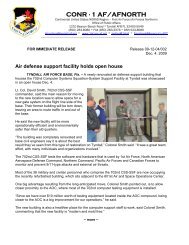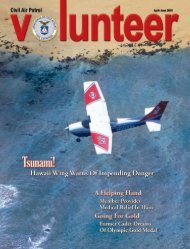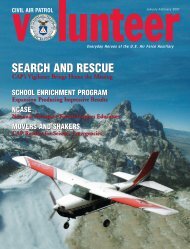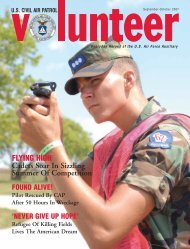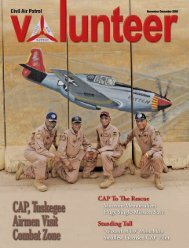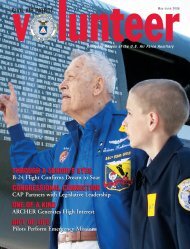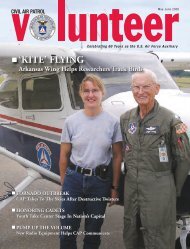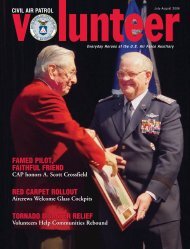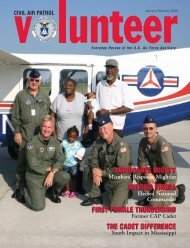CAPITAL CLOSE-UP
Hi-res - CAP VolunteerNow
Hi-res - CAP VolunteerNow
- No tags were found...
Create successful ePaper yourself
Turn your PDF publications into a flip-book with our unique Google optimized e-Paper software.
Airmen,” an HBO drama, which first aired in August<br />
1995. Both productions highlighted the feats of these airmen,<br />
who were battling the real enemy, the Germans,<br />
and often were faced with an enemy within their own<br />
Army Air Forces — racism.<br />
These racist attitudes were documented in official<br />
U.S. War Department documents from the Army<br />
Historical Institute at Carlisle Barracks, Pa., in 1925.<br />
The documents said that blacks lacked the brains and<br />
courage to be combat airmen. Yet, despite this hostile<br />
environment on the homefront, the Tuskegee Airmen<br />
persevered.<br />
“I think the pilots coming out of Tuskegee were as<br />
good as any,” said Gray.<br />
The pilots were called “Red Angels” because their<br />
aircraft tails were painted red.<br />
“We were just doing what we had to do,” said<br />
Gray, who enlisted from Boston in the Army Air<br />
Forces. He graduated from Boston English High<br />
School in 1942.<br />
Lt. Col. Leo Gray, above, as a<br />
Tuskegee Airmen cadet, is still<br />
active with the Civil Air Patrol. At<br />
left, Gray poses for a photo at<br />
Challenge Air 2007 in Fort<br />
Lauderdale.<br />
Former Kansas Wing Commander<br />
Col. George M. Boyd, right, became<br />
a Tuskegee Airmen cadet in 1944.<br />
Impeccable military records<br />
Following his pilot training at Tuskegee, Gray flew<br />
15 missions out of Italy during War World II as a<br />
pilot with the 100th Fighter Squadron, 332nd Fighter<br />
Group. His job was to protect and escort the Allied<br />
bombers flown by white pilots.<br />
“We did that to the best of our ability,” Gray said,<br />
noting the black pilots who got their wings at<br />
Tuskegee destroyed or damaged 409 enemy aircraft,<br />
including 112 destroyers in aerial combat. But they<br />
paid a price. Seventy-eight Tuskegee Airmen were<br />
killed overseas, most of them by ground fire or routine<br />
aircraft accidents. But 12 were killed in aerial combat.<br />
In addition, 34 of the airmen were captured and<br />
became prisoners of war. Numerous airmen were<br />
downed but managed to evade capture by the enemy.<br />
“You never knew when you went on a mission if<br />
you were going to come back,” Gray told the Sun-<br />
Sentinel.<br />
Boyd, a member of Class 45-G, became a Tuskegee<br />
Airman in 1944, shortly after Gray. A native of<br />
Civil Air Patrol Volunteer 30 May-June 2007



